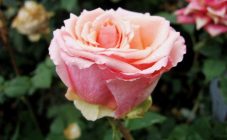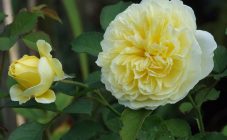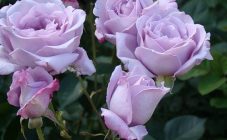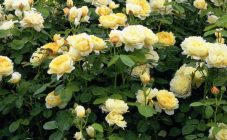Content:
You don't even need to ask flower growers what flowers they prefer to grow in their garden plots - naturally, these will be roses. Various shades of petals of blossoming buds, perfectly combined with emerald foliage, the neat shape of the bushes, the ability to grow singly and in group compositions - these and other qualities are the main reasons for the popularity of this "queen of flowers" among gardeners around the world.
And although among the colors of rose petals of different varieties, perhaps only blue is not found, still the most beautiful and delicate are white roses. However, there are not many varieties of these flowers in the world. The famous English breeder David Austin has bred few varieties of roses with these petal colors. Claire Austin's snow-white rose is one of the main gems in his collection. The dazzling white flowers blooming on the erect shoots of Claire's rose immediately attract attention.
The history of the creation of the variety
In the collection of rose varieties created by the English breeder Austin, the main emphasis was placed on the development of flowers with yellow and orange petals. But there are very few white varieties among Austin roses. The fact is that breeders say that the breeding of such plants is a rather complicated and long process, therefore, among the whole variety of varieties of the "queen of flowers", it is rarely possible to meet snow-white flowers.
When breeding Claire Rose, David Austin crossed a hybrid tea rose with a French variety. The new variety turned out to be much more beautiful and graceful than its "parents" and became the best of all varieties of roses bred by the breeder.
There are currently two varieties of the Claire Austin rose:
- bush;
- curly.
Characteristics and features of the variety
The description of the rose Schrab Claire Austin should begin with a story about the flowers blooming on this perennial. During the flowering period, up to 100-120 buds appear on these bushes, some of which are just beginning to bloom, others are actively blooming, and some are already finishing flowering.
The buds are densely double, the petals are white with a slight lemon tint. The pleasant strong aroma of these flowers is a mixture of tea rose scent, notes of myrrh and vanilla. The diameter of the blossoming buds is up to 10 cm.
The first time the Claire Rose rose blooms in the second decade of June, and the second - in the first decade of August. Then flowering continues until the second decade of September.
Sprawling bushes are heavily leafy, stems are drooping. The height of the shoots is up to 1.5 m, and the width of the bushes is about a meter. The leaves are bright emerald in color, the leaf plates are small, glossy with a characteristic shine.
In the Moscow region and regions with similar climatic conditions, the Claire Austin rose grows as a variety of floribunda roses. But in regions with a mild and warm climate, with proper care, such a variety in size and height of the lashes becomes similar to climbing roses.
This variety is distinguished by its high resistance to cold weather. Also, experts note the average resistance of Claire's rose to powdery mildew and black spot. At the same time, the perennial tolerates the rainy season well and does not reduce active flowering.
This concludes the story about the main characteristics of this flowering perennial.
Agricultural technology of cultivation
For planting Claire Austin seedlings, you should choose a well-lit area that will be protected from gusts of cold wind and drafts. It is best suited for planting a site located next to a blank fence or near the walls of garden buildings. The soil should be loose and allow moisture to pass through well - for these flowering perennials, stagnation of water in the ground or groundwater close to the surface is unacceptable.
Planting seedlings is best done from the second decade of April to the second decade of May. Flowers planted in autumn can hardly endure the frosty winter, since they will not have time to acclimatize well in the open field.
The diameter of the planting pit should be about 0.7 m, and the depth - 0.65 m.A layer of drainage material (broken brick, crushed stone) should be laid on the bottom, the thickness of such a layer should be 5-6 cm. The next layer is a nutrient soil mixture, consisting from garden soil, compost, river sand and high-moor peat. Then a seedling is installed in the pit, its roots are gently straightened over the entire hole and covered with the rest of the substrate on top. The soil is lightly tamped from above and watered. At least 8-10 liters of settled water should be poured onto each bush. After watering, a layer of mulch with a thickness of 6-7 cm is applied to the trunk circle.
Further care for these bushes is to carry out agrotechnical measures:
- regular watering at least once every 6-7 days (in the heat, the number of waterings is increased);
- loosening of near-trunk circles with simultaneous removal of weeds;
- preventive treatment of bushes from diseases and pests.
If the site was well fertilized before planting, then in the first season it is not worth feeding.
But in subsequent seasons, fertilizers should be applied under the rose bushes at least 3 times:
- in the spring, before the buds swell, nitrogen fertilizers and rotted manure or compost should be added to the soil;
- when the first buds appear, complex mineral fertilizers containing potassium and phosphorus should be added to the soil;
- in early August, fertilizing with phosphorus and potassium fertilizers is repeated.
In the spring, before the buds begin to bloom, pruning of the bushes should be carried out, removing frozen, broken off and dry branches. Also, if necessary, you should thin out the bush, removing excess and weak shoots.
Preparation of this flowering perennial for winter should be started from the first decade of October. The stems are bent to the ground and fixed. They do this carefully, trying not to damage or break the stems. Before covering the rose bushes, you should remove all the foliage from the shoots so that harmful insects and pathogenic microorganisms do not hide in it for the winter. From above, the shoots are covered with spruce branches, and from above - with a special covering material.
Advantages and disadvantages of the variety
Florists who grow this variety on their plots note its main advantages:
- high resistance to frost;
- if in the spring the frozen shoots are cut off strongly, then during the summer season they quickly grow back to their original size;
- there are practically no thorns on the shoots;
- flowers are well suited for cutting, they can stand in vases for up to 12-14 days.
This beautiful perennial has practically no drawbacks. At least among the gardeners' reviews, there were no obvious disadvantages of the variety.
Claire Austin is a rose with amazing characteristics that are difficult to find among other varieties. Considering that this variety can be successfully grown in the Moscow region and other regions with a similar climate, Russian flower lovers should pay attention to it.

















